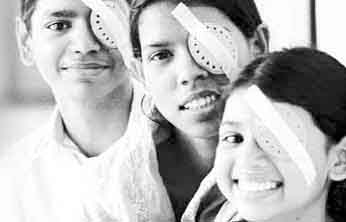
The role of media in eliminating avoidable blindness
Parvez Babul | Saturday, 25 January 2014

Just close your eyes for a few moments and feel how dreadful darkness is. In fact, no one wants to stay living with darkness, in other words, blindness. But millions of our children are living a life without light. In order to enable all children to see this beautiful world, let us say 'No' to childhood blindness. In order to achieve this goal, we must work for 'prevention of avoidable blindness and visual impairment', bearing in mind that it is a human, social and developmental issue. Media, being the eyes, ears and tongues of the nation, may accommodate and disseminate more information both critically and crucially to help eliminate avoidable blindness.
The World Health Organisation (WHO) estimates that up to 60 per cent of children in low-income countries are likely to die within one year of becoming blind. Moreover, around 500,000 children become blind each year. This equates roughly to one child becoming blind each minute. Many of the conditions associated with childhood blindness are also causes of child mortality.
Most of the causes of avoidable blindness in low-income countries are directly related to poverty, hunger, malnutrition, and limited access to health, education, water and sanitation. These problems are most acute in the least developed countries, which are home to more than 90 per cent of the world's visually impaired people. An estimated 153 million people suffer from low vision due to uncorrected refractive errors; at least 13 million among them are children.
The prevalence of cataract and refractive error (myopia, short-sightedness) is increasing dramatically among children, particularly in rural and urban areas of South-East Asian countries including Bangladesh. Recently, at a Child Sight-Fred Hollows Foundation's media fellowship programme in Dhaka, Child Sight Foundation said that 40,000 children are blind in Bangladesh, of which 12,000 are due to cataract. Helen Keller International said that diabetic retinopathy is a leading cause of blindness of adults. It is a common complication that affects 50 per cent of people with diabetes within the first 15 years of diagnosis. Bangladesh is currently home to more than three million diabetics, and it is expected to reach 11 million by the year 2020. It is a matter of great concern that 90 per cent of the doctors and their helpers live in urban areas in Bangladesh. That is why many rural people are deprived of eye care services.
Eye health experts observed that blindness is often an avoidable disability. As 75 per cent blindness is avoidable, it means either blindness is preventable or curable. Actions by individuals, families, communities, eye care professionals, as well as mass media are vital to achieving the ambitious targets of 'Vision 2020: The Right to Sight', a joint programme of the World Health Organisation (WHO) and the International Agency for the Prevention of Blindness (IAPB) with an international membership of NGOs, professional associations, eye care institutions and corporations. The initiative aims to prevent 100 million cases of blindness by the year 2020. The ultimate goal is to integrate a sustainable, comprehensive, high-quality, equitable eye care system into strengthened national health-care systems.
Seven out of the eight Millennium Development Goals (MDGs) depend on measures linked to the implementation of Vision 2020. As the causes of blindness in children differ from those in adults, different control measures are needed. In low-income countries, high proportions of children are blind due to preventable causes; this requires community-based interventions.
The number of blind children and adults is increasing due to the increase in population and the immense shortage of ophthalmologic equipment and personnel. Eye health professionals emphasised on health education for the mass people especially on eye health. And two most important health education methods they mentioned are mass media and face to face communication, either separately or together.
Mass media have the potential to reach large numbers of population to disseminate information for making awareness in preventing avoidable blindness and helping the blind children see. Newspapers, television, radio and other media are important tools for effective advocacy. So, it is important to find out what media are available where, who accesses them. Thus the messages should be delivered based on population, target audiences, their languages, needs and demands. A key element of effective mass media is initial research and testing of programmes before print, or broadcast to ensure that messages are simple, relevant, attention-growing, easily-understandable, and attractive.
In terms of behaviour change communication, it is generally accepted that mass media are particularly appropriate when the behaviour changes are to be promoted. Even those, who are underpinned by strong cultural beliefs, mass media need to be supplemented by more intensive community-based approaches.
Advocacy through media includes all activities designed to raise awareness about the importance of blindness prevention among all, from the grassroots level to policy making level, mobilise resources, and integrate blindness prevention programmes with other programmes. Advocacy can also lead to enactment and enforcement of laws that place on a legal footing the obligations of governments to ensure the 'Right to Sight'. The print, electronic, online, and social media have huge opportunities to contribute to preventing avoidable blindness and help achieve the goals of Vision 2020: The Right to Sight. Even many profit or non-profit organisations may use media for advocacy in eliminating avoidable blindness as part of their corporate social responsibilities.
The writer is a journalist
and social activist.
parvezbabul@gmail.com